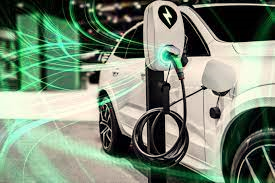
E-Mobility Market by Product Type (Electric Skateboard, Electric Car, Electric Motorcycle, Electric Wheelchair, and Electric Scooter), Battery Type (NiMH, Sealed Lead Acid, and Li-ion), and Voltage Type (Less than 24V, 24V, 36V, 48V, and Greater than 48V) – Global Opportunity Analysis and Industry Forecast 2022–2030
Industry: Automotive & Transportation | Publish Date: 06-Jan-2023 | No of Pages: 413 | No. of Tables: 350 | No. of Figures: 311 | Format: PDF | Report Code : N/A
Market Overview
The global E-Mobility Market was valued at USD 279.51 billion in 2021 and is projected to reach USD 2305.33 billion by 2030 at a CAGR of 26.9% from 2022–2030.
E-mobility or electric mobility refers to the shift from internal combustion engine (ICE) vehicles to battery-powered electric vehicles (EVs). It represents the concept of integrating electric powertrain technology, in-vehicle information and communication technologies, and connected infrastructures to enable the vehicle’s electric power.
A vehicle’s powertrain technology can be full electric, plug-in hybrids, or hydrogen fuel cell vehicles that converts hydrogen into energy. Automotive E-mobility includes a wide range of EVs such as electric cars, e-bikes, pedelecs, electric motorbikes, e-buses, and e-trucks, all of which are entirely or partially powered by electricity.
In addition, EVs are gaining popularity as they adhere to the low-emission standard, which is crucial for preserving the environment and improving people’s quality of life. Also, due to lack of combustion engines, electric vehicles avoid emission of greenhouse gases that aid in fighting against the consequences of climate change.
Increasing Demand for Emission-Free Vehicles Propels the Market Growth
Legislations supporting the use of energy-efficient vehicles are being implemented as a result of the rising concerns about the continuously increasing greenhouse gas and carbon footprint from the automotive and transportation sector. Governments worldwide are striving to reduce carbon emissions and combat climate change by imposing stringent emission standards.
For instance, in April 2022, U.S. Department of Transportation’s Federal Highway Administration announced a Carbon Reduction Program (CRP) to develop carbon reduction strategies and address the climate crisis. This program focused on reducing transportation-related pollution and cutting carbon emissions. The rise in demand for zero-emission vehicles is contributing to the growth of the E-mobility industry.
Also, the government offers various policies for disposing of conventional or fossil fuel-powered vehicles and promoting the demand for emission-free vehicles, which in turn is further driving the market growth.
For instance, in March 2022, the US state of Washington passed a bill to target all vehicles of the model year 2030 or later that are sold, purchased, or registered in Washington shall be EVs. Thus, the shift of consumers to EVs is increasing due to the growing uncertainty over the adoption and future use of conventional or fossil fuel-powered vehicles, which in turn propels the growth of e-mobility market.
Low cost of lithium-ion batteries boosts the market for E-mobility
The invention of the lithium-ion battery helped the development of EVs due to its advanced features as compared to older batteries in terms of cost, rechargeability, durability, energy density, and power capacity. Due to recent technological advancements, the cost of lithium-ion batteries has significantly decreased and automakers have also been focusing on mass producing these batteries.
In addition, due to its improved technologies, lithium-ion batteries can be used in a wide range of vehicles including 2-wheelers, 3-wheelers, cars, and buses. Moreover, the growing adoption of Mobility-as-a-Service (MaaS) and the declining prices of large-capacity lithium-ion batteries lead to the increasing adoption of EVs, which in turn is further expected to drive the e-mobility market growth.
Lack of Semiconductor Chips and Charging Infrastructure Hinders the Market Growth
The global shortage of semiconductor chips that are tiny but vital, which are required to manage infotainment systems, regulate cars’ fuel injection and provide cruise control, has reduced the overall production of EVs, thereby restraining the growth of the e-mobility market. The development of EVs is restrained owing to shortage of essential EV charger components and precious metals, such as lithium; this is further expected to restrain the market growth.
Moreover, the insufficient standardization of EV charging infrastructure that increased the installation cost of charging stations leads to lower public adoption of EVs, which in turn hinders the market growth.
Increasing Adoption of Solar-Powered EV Charging Infrastructure Creates Opportunity
The demand for electricity is expected to surge as a result of the increase in EVs. Manufacturers of EVs around the world are working towards a sustainable increase in electric production, using hydroelectric dams, solar farms, and wind farms to reduce the carbon emissions of fossil fuel electricity generation.
The solar-powered devices are fast, inexpensive substitutes for grid-tied charging infrastructure and reduce carbon emissions, which increases the accessibility of charging stations and adoption of EVs; this contributes to ample growth opportunities for the E-mobility industry in the near future.
The Asia-Pacific Market Holds the Dominant Share of E-Mobility Market
Asia-Pacific region holds the largest share and is expected to continue its dominance during the forecast period. This is attributed to factors including several government initiatives to drive the adoption of EVs and charging infrastructure facilities across this region.
For instance, in September 2022, the Chinese Government announced an exemption from the tax levied on EV purchases to the end of 2023. The tax exemption aimed to bolster the increased use of battery-powered cars on mainland Chinese roads.
Also, in November 2021, the Japanese government announced an investment of a total of USD 26 million for E-mobility in a supplementary budget for 2021. This fund is divided to invest in vehicles with battery-electric, plug-in hybrid and fuel cell drive systems around USD17 million; USD 5 million is earmarked for new charging stations and 4 million yen for new hydrogen filling stations.
Moreover, China dominates the electric market in this region, which in turn drives the e-mobility market growth. According to the International Council on Clean Transportation, China holds the largest market share of the EV market owing to the presence of policymakers with stringent, innovative regulations. This results in China moving into a leadership role in transport climate policy.
Europe is Growing Steadily in the E-Mobility Market
Europe is expected to show a steady rise in the e-mobility market owing to the surge in the number of unit sales of electric cars and vans. According to the International Council on Clean Transportation, the sales of EVs in Europe were 2.3 million in 2021, a 66% increase from 2020.
Also, the growing government initiatives to decarbonize transportation due to the growing concerns regarding the negative environmental effects of vehicular emissions contribute to the growth of the automotive e-mobility market in this region.
For instance, in July 2021, the European Union proposed an effective ban on the sale of new petrol and diesel cars from 2035. This proposal aims to speed up the transition to zero-emission EVs as part of a broad package of measures to combat global warming.
Competitive Landscape
The e-mobility market trends include various market players such as Tesla Inc., Nissan Motor Corporation, BMW Group, General Motors Company, Honda Motor Company, Ltd., Toyota, Accell Group, Volkswagen AG, Ford Motor Company, and Hyundai Motor Company. These market players are adopting several strategies such as product launches, partnerships, and business expansions across various regions to maintain their dominance in the global market.
For instance, in August 2022, BMW announced the expansion of EV components production in its Leipzig plant in Germany, with the inauguration of the second production line for battery modules with an investment of around USD 68 million. It aims to produce high-voltage battery modules for BMW Group vehicles. Business expansion increases the market share and customer base of a company as well as improves operational activities and cost savings.
Also, in July 2022, Tesla announced strategic partnership with General Motors to expand EV infrastructure. This partnership aimed to meet the demand for EVs and support the growing network with the required infrastructure. The partnership among the key players benefitted customers with advanced EV products and infrastructure during the forecast period.
Moreover, in April 2022, Toyota launched its first all-electric SUV in May, which starts from $42,000 and offers superior power efficiency performance and sufficient cruising range for practical driving. A total of 5,000 units for production and sales are planned for the first year. The new launch of electric vehicles creates tough competition among the players that contributes to further push the players to innovate advanced products and satisfy customers.
E-Mobility Market Key Segments
By Product Type
-
Electric Skateboard
-
Electric Car
-
Electric Motorcycle
-
Electric Wheelchair
-
Electric Scooter
-
Standing/Self-Balancing
-
Retro
-
Folding
-
By Battery Type
-
NiMH
-
Sealed Lead Acid
-
Li-ion
By Voltage Type
-
Less Than 24V
-
24V
-
36V
-
48V
-
Greater than 48V
By Geography
-
North America
-
U.S
-
Canada
-
Mexico
-
-
Europe
-
UK
-
Germany
-
France
-
Spain
-
Italy
-
Netherlands
-
Denmark
-
Finland
-
Norway
-
Sweden
-
Russia
-
Rest of Europe
-
-
Asia-Pacific
-
China
-
Japan
-
India
-
Australia
-
South Korea
-
Thailand
-
Singapore
-
Rest of Asia-Pacific
-
-
RoW
-
Latin America
-
Middle East
-
Africa
-
Report Scope and Segmentation
Parameters |
Details |
|
Market Size in 2022 |
USD 341.84 Billion |
|
Revenue Forecast in 2030 |
USD 2305.33 Billion |
|
Market Volume in 2022 |
41131.47 |
|
Volume Forecast in 2030 |
273160.43 |
|
Growth Rate |
CAGR of 26.94% from 2022 to 2030 |
|
Analysis Period |
2021–2030 |
|
Base Year Considered |
2021 |
|
Forecast Period |
2022–2030 |
|
Market Size Estimation |
Billion (USD) |
|
Growth Factors |
Increasing demand for emission-free vehicles |
|
Countries Covered |
26 |
|
Companies Profiled |
10 |
|
Market Share |
Available for 10 companies |
|
Customization Scope |
Free customization (equivalent up to 80 analysts working hours) after purchase. Addition or alteration to country, regional & segment scope. |
|
Pricing and Purchase Options |
Avail customized purchase options to meet your exact research needs. |
KEY PLAYERS
-
Tesla Inc.
-
Nissan Motor Co. Ltd
-
BMW
-
General Motors Company
-
Honda Motors
-
Toyota Motor Corporation
-
Accell
-
Volkswagen AG
-
Ford Motor Company
-
Hyundai Motor Company




 Speak to Our Analyst
Speak to Our Analyst
































